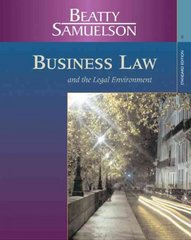Question
Sea lion bycatch is a major problem in Southern Australia. A primary cause of sea lion mortality in that region is the sea lion bycatch
Sea lion bycatch is a major problem in Southern Australia. A primary cause of sea lion mortality in that region is the sea lion bycatch associated with the gillnet fishery there. To address this negative externality, the Australian government is considering to implement one of the two policies on Australian fishers who engage in harvesting activities that result in sea lion bycatch.
Policy A:Regulation - an allowablebycatchstandard(number of sea lions) for each fisher. If a fisher violates the bycatch standard (i.e., ends up catching more sea lions than the standard allows) at the end of the fishing season, he has to pay a lump sum fine.
Policy B:An earlyseasonal closureso that fishers have a shorter time span to go fishing.
Let us assume the Australian government has a perfect monitoring system to see how many sea lions are being caught.
If Policy A is implemented, each fisher can either meet the standard by adjusting his fishing behavior. Or, he can pay the fine and harvest as much he wants to maximize his profits without worrying about the sea lion bycatch. If the fishermeets the standard, his profit is $9000 and the Australian government benefit is worth $1200 (think of it as a benefit (in dollar terms) to society from reduced sea lion bycatch). If the fisher chooses topay the fine, the fisher's profit is $7500 and the government's benefit is worth $500 (no benefit from reduced sea lions but say the government can use $500 for conservation efforts to protect sea lions).
If Policy B is implemented, the fisher can respond in two alternative ways - (i)increase fishing effortper day during the shorter fishing and harvest very intensively (this behavior is known as the "race to fish" behavior) or (ii) continue to fish the same way (i.e.,unchanged fishing effort). If the fisher decides to race to fish, his profit is $6000 and the Australian government's benefit is $600. If the fisher continues to fish the same way as in the past, his profit is $4500 and the Australian government's benefit is worth $850.
Q1: What are thesubgame perfect Nash Equilibrium (SPNE)strategiesfor the Australian government and the fisher?
a. Australian government will choose policy A. If the government chooses policy A, the fisher will choose to pay the fine. If the government chooses policy B, the fisher will choose to race to fish.
b. Australian government will choose policy B. If the government chooses policy A, the fisher will choose to meet the standard. If the government chooses policy B, the fisher will choose to race to fish.
c.
Australian government will choose policy A If the government chooses policy A, the fisher will choose to meet the standard. If the government chooses policy B, the fisher will choose to race the fish.
d. Australian government will choose policy B. If the government chooses policy A, the fisher will choose to pay the fine. If the government chooses policy B, the fish choose continue fishing the same way (unadjusted fishing behavior).
Q2: What will the subgame perfect NEoutcome?
a. (A) The Australian government will receive 500 and the fisher will make 7500.
b. The Australian government will receive 1200 and the fisher will make 9000.
c. The Australian government will receive 600 and the fisher will make 6000.
d. The Australian government will receive 850 and the fisher will make 4500.
Step by Step Solution
There are 3 Steps involved in it
Step: 1

Get Instant Access to Expert-Tailored Solutions
See step-by-step solutions with expert insights and AI powered tools for academic success
Step: 2

Step: 3

Ace Your Homework with AI
Get the answers you need in no time with our AI-driven, step-by-step assistance
Get Started


